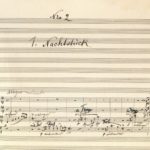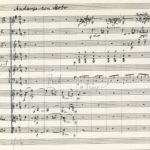
Gustav Mahler's Symphony No. 7 was written in Year 1904 and Year 1905, with repeated revisions to the scoring. Although the symphony is often described as being in the key of E minor, its tonal scheme is more complicated. The symphony's Movement 1: Langsam (Adagio) - Allegro risoluto, ma non troppo moves ...
Read More

Among the manuscripts preserving the earliest stages of the composition of Symphony No. 7, a most important group of sketches for the first movement of the work, together with one for the last, is found in the Theatermuseum (theatre collection) in Vienna, as part of the estate of the singer Anna Bahr-von ...
Read More

The fair copy of the full score was a gift from Alma Mahler (1879-1964) to the Dutch conductor Willem Mengelberg (1871-1951) on her visit to the Gustav Mahler Festival Amsterdam 1920. See her entry in the commemorative book. Willem Mengelberg (1871-1951) bequeathed it to the Amsterdam Royal Concertgebouw thereby ensuring that the manuscript remained in the Netherlands. Facsimile edition ...
Read More

- First movement.
- Moves from B minor (introduction) to E minor.
The movement is in sonata form. It begins with a slow introduction in B minor, launched by a dark melody played by a baritone horn. The accompanimental rhythm was said to have come to Mahler whilst rowing on ...
Read More

- Nachtmusik I.
- Andante, C major/minor.
The movement opens with horns calling to each other. The second horn is muted, however, to create the illusion of distance. Scampering woodwinds imitating somewhat grotesque bird calls pass off into the distance, as the trumpets sound the major-minor seal from the sixth ...
Read More

- Scherzo.
- D minor - The German marking ´Schattenhaft´ means ´Shadowy´. Flowing but not too fast.
There is an undercurrent of night about the spooky third movement; while "Scherzo" means "joke", this movement is remarkably spooky and even grim. If the first 'Nachtmusik' possessed a friendly mood disguised in ...
Read More

- Nachtmusik II.
- F major.
The fourth movement (the second 'Nachtmusik') contrasts with the first in that it illustrates a more intimate and 'human' scene. With its 'amoroso' marking and reduced orchestration (trombones, tuba and trumpets are silent and the woodwinds are reduced by half) this movement has been ...
Read More

- Finale.
- C Major.
Boisterous timpani joined by blazing brass set the scene for the riotous fifth movement. The long, arduous first movement, after three shorter movements developmental in mood, is finally equalled by a substantial 'daylight' finale. The movement is a rondo combined with a set of eight ...
Read More

Woodwind
- 1 Bass clarinet A.
- 1 Bass clarinet B.
- 3 Bassoon.
- 3 Clarinet A.
- 3 Clarinet B.
- 1 Clarinet Eb.
- 1 Contra bassoon.
- 1 Cor Anglais (English horn).
- 4 Flute.
- 3 Oboe.
- 1 Piccolo.
Brass
- 1 Alt trombone.
- 1 Contra bass tuba.
- 4 Horn F (French horn) ...
Read More


